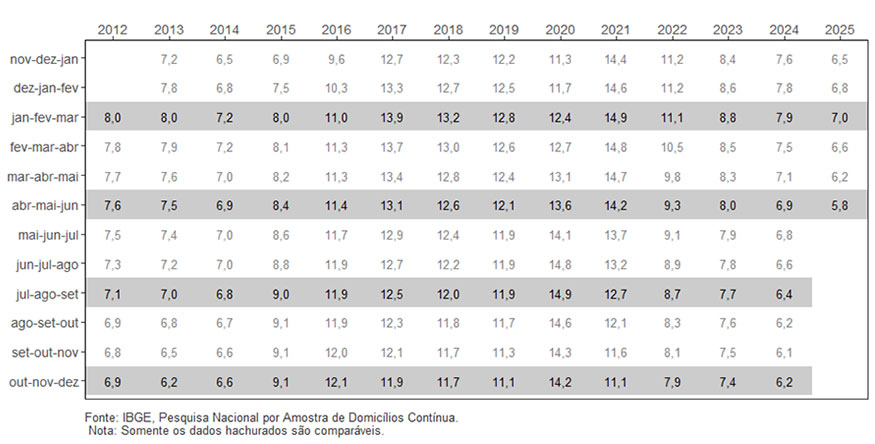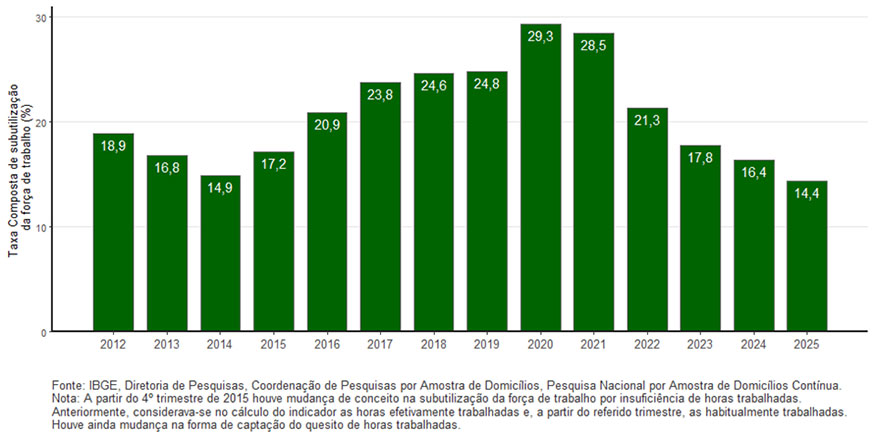Continuous PNAD: unemployment rate is 5.8% and underutilization hits 14.4% in quarter ended June
July 31, 2025 09h00 AM | Last Updated: August 05, 2025 01h37 AM
The data presented in this release come from the Continuous PNAD reweighted series.
The unemployment rate (5.8%) in the quarter ended June 2025 was the lowest in the time series initiated in 2012, with drops in both comparisons: -1.2 percentage points (p.p.) from the previous quarter (7.0%) and -1.1 p.p. from the moving quarter ended June 2024 (6.9%).
| Indicator/Period | Apr-May Jun 2025 | Jan-Feb-Mar 2025 | Apr-May -Jun 2024 |
|---|---|---|---|
| Unemployment rate | 5.8% | 7.0% | 6.9% |
| Underutilization rate | 14.4% | 15.9% | 16.4% |
| Usual real earnings | R$ 3,477 | R$ 3,440 | R$ 3,367 |
| Change of the usual earnings in relation to: | 1.1% | 3.3% | |
The unemployment population (6.3 million) decreased by 17.4% (1.3 million persons) in the quarter and dropped 15.4% (1.1 million persons) in the year.
The employed population (102.3 million) was a record in the time series, with increase in both comparisons: 1.8% (1.8 million) in the quarter and 2.4% (2.4 million) in the year.
The employment population ratio (percentage of employed persons in the working-age population) repeated the recorded result of the quarter ending in November 2024: 58.8%, with increase in both comparisons: 0.9 percentage points in the quarter (57.8%) and 1.0 percentage points (57.8%) in the year.
The composite underutilization rate (14.4%) was the lowest in the series, with drops in both comparisons: -1.5 percentage points against the previous quarter (15.9%) and -2.0 percentage points against the same quarter in 2024 (16.4%). The underutilized population (16.5 million) fell in both comparisons: -9.2% (1.7 million) in the quarter and -11.7% (2.2 million) in the year.
The time-related underemployed population (4.6 million) remained stable in the quarter and fell 8.3% (415 thousand persons) over the year. The population out of the workforce (65.5 million) remained stable in both comparisons.
The discouraged population (2.8 million) fell by 13.7% (436 thousand persons) in the quarter and 14.0% (449 thousand persons) over the year. The percentage of discouraged workers (2.5%) dropped 0.4 p.p. in the quarter and fell by 0.4 p.p. over the year.
The number ofworkers in the private sector (52.6 million) increased in both comparisons: 1.3% (696 thousand persons) in the quarter and 2.7% (1.4 million) over the year.
The number of workers with a formal contract in the private sector (except domestic workers) reached a record high in the time series, reaching 39.0 million, with increases in both comparisons: 0.9% (357 thousand persons) in the quarter and 3.7% (1.4 million persons) over the year. The number of workers without a formal contract in the private sector (13.5 million) increased 2.6% (338 thousand persons) in the quarter and remained stable throughout the year.
The number of workers in the public sector (12.8 million) reached a record high in the series and increased in both comparisons: 5.0% (610 thousand persons) in the quarter and 3.4% (423 thousand) in the year.
The number of self-employed workers (25,8 million) hit a record figure and increased in both comparisons: 1.7% (426 thousand persons) in the quarter and 3.1% (767 thousand) in the year.
The informality rate was 37.8% of the employed population (or 38.7 million informal workers), compared to 38.0% (or 38.2 million) in the quarter ended March 2025 and 38.7% (or 38.6 million) in the quarter ended June 2024.
Usual real earnings from all jobs (R$ 3,477) hit a record figure, with increase in both comparisons: 1.1% in the quarter and 3.3% in the year.
Theusual real wagebill (R$ 351.2 billion) hit a record result, with increases of 2.9% (R$ 9.9 billion) in the quarter and 5.9% (R$ 19.7 billion) in the year.
Unemployment rate - Brazil - 2012/2025
The workforce (employed and unemployed persons) reached 108.6 million in the April-June 2025 quarter, a record increase in the time series, growing 0.5% (an increase of 492,000 people) against the January-March 2025 quarter. Compared to the same quarter in 2024, there was a 1.2% increase (of 1.3 million persons).
The analysis of employment by group of activity in relation to the previous moving quarter showed an increase only in Public administration, defense, social security, education, human health, and social services (4.5%, or an increase of 807,000 persons), with stability in the others.
Against April-June 2024, there was an increase in the following groups: General Industry (4.9%, or 615,000 persons), Trade, repair of motor vehicles and motorcycles (3.0%, or 561,000 persons), Transportation, storage and mailing (5.9%, or 331,000 persons), Information, Communication and Financial, Real Estate, Professional and Administrative Activities (3.8%, or 483,000 persons) and Public administration, defense, social security, education, human health and social services (3.7%, or 680,000 persons). The other groups did not show significant changes.
Composite underutilization rate – Quarters of April-June – Brazil – 2012 to 2025 (%) 
Average monthly real earnings by group of activity, against the previous moving quarter, showed an increase in the category Trade, repair of motor vehicle and motorcycles (2.6%, or more than R$72). The other groups remained stable.
Against the April-June 2024 quarter, there were increases in four categories: Agriculture, livestock, forestry, fishing, and aquaculture (7.0%, or more than R$144); Construction (5.8%, or R$148); Trade, repair of motor vehicles and motorcycles (3.3%, or R$92); and Information, Communication, and Financial, Real Estate, Professional, and Administrative Activities (4.7%, or R$220) and Domestic services (4.1%, or R$53). The other groups showed no significant change.
Average monthly real earnings by employment type, from the previous quarter, remained stable across all categories. Compared to the April-June 2024 quarter, there were increases in the following categories: Workers with a formal employment contract (2.2%, or R$68), Workers without a formal employment contract (7.9%, or R$180), Domestic workers (4.1%, or R$53), and Self-employed (5.3%, or R$146).
IBGE Updates Continuous PNAD Based on 2022 Population Census Data
Starting today, July 31, 2025, the moving quarter estimates for Continuous PNAD have been updated and reweighted to reflect IBGE's new population estimates, based on the 2022 Census.
The populations used to calculate the Continuous PNAD's expansion factors have been updated, maintaining the methodology previously adopted for the survey reference dates. Further details on this reconsideration are available in the technical note, here.

